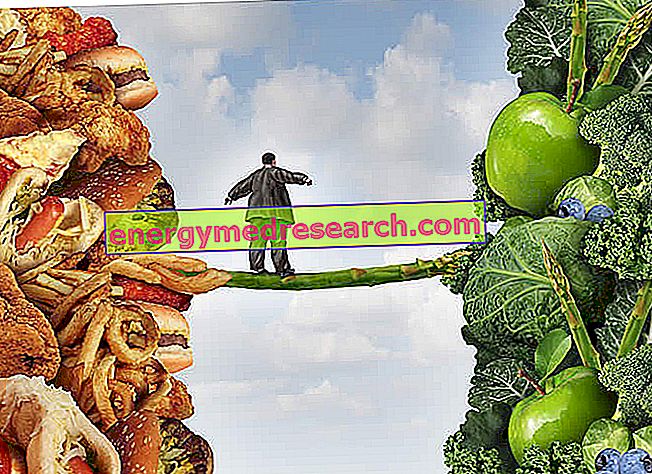Greasing: What does it mean?
Greasing is a generic term, to be precise a verb, which (referring to an individual) describes the increase (absolute or relative) of the adipose mass .
This increase generally manifests itself in the growth of body mass and overall weight; however, in particular conditions, these parameters can also remain stable. In other words, within certain limits of increase, it is possible to put on weight (increase the adipose mass) without an increase in body weight.

There is Grasso and Grasso
Body fat can be differentiated or classified in various ways. What is certain is that it is not a useless or optional element for our organism, which is why part of it is called " Essential or Primary Fat ".

The essential fat is constituted by the adipose parts of: cellular membranes, nerve myelin sheaths, bone marrow, mammary glands, kidneys, heart, liver, intestines, spleen, lungs etc.
- Overall, essential fat accounts for 3-5% of the mass in humans and 8-12% for women (especially for the mammary glands).
- The total adipose mass constitutes about 12-15% in men and 25-28% in women (which in any case is more subject to retaining lipid reserves). These percentages therefore include both essential fat and storage fat.
When weight loss goes to affect the essential fat (borderline cases, such as in malnutrition in the third world or in severe anorexics), major disorders for general health begin, which endanger the very survival of the organism.
NB . It is said that the so-called brown fat is basically visceral; its function is not to act as an energy reserve (like the white subcutaneous one), but to participate in the thermoregulation of the organism.
Special Cases
An example of fattening while maintaining a constant weight can occur with the sudden and sudden interruption of Body Building activity. In particular, if the suspension or reduction of physical activity is associated with inappropriate food behaviors (in which alcohol and junk food abuse is often involved), the increase in adipose mass can be offset by a decrease in lean mass. The result is that the person gains weight while maintaining a constant body weight.
Less significant and much more widespread is the significant reduction in lean mass while keeping the fat mass unchanged. In this case the subject gets fat (in a relative manner) despite the drop in body weight which may suggest the opposite. Similar to the previous case, this circumstance, which is hardly perceived as "fattening", can manifest itself in the interruption of sporting activities, especially at high levels.
It must then be said that in most cases fattening is the fruit of individual perception, or of the way in which the mind elaborates and contextualizes the image and the body dimensions. For the vast majority of cases, interpretation is in favor of increasing the adipose mass, more rarely the opposite.
It must also be specified that, in certain cases, the increase in adipose mass is not so easily identifiable. A fairly indicative example of this phenomenon is that which occurs during the phases of " building muscle mass " in bodybuilding. Fortunately, nowadays we are well aware that it is always better not to exceed and that, in any case, subjecting the organism to a predominantly anabolic phase is "normal" that it also slightly increases the fat mass. However, in gyms we often hear of "big results" in terms of muscle mass, penalized only by a mild subcutaneous water retention. Notwithstanding that the increase in body water is in any case probable, considering that during the phase of "muscle definition" or "cutting" the opposite occurs (tendency to dehydration which must subsequently be normalized); moreover, some food supplements such as creatine could emphasize this trend. It is however necessary to specify that water retention can reach certain levels (several kilograms) only in the presence of pathological conditions; therefore, in general it is not interstitial water but lipid in fat; furthermore, body fat is not deposited exclusively in adipose tissue, but also inside the striated muscles . This detail is clearly visible when looking at certain cuts of meat; in particular, scrutinizing a rib steak made from the famous Wagyu Kobe cattle (which is obviously an extreme case); in practice, the much-vaunted "mass phase" always causes the body to gain weight more or less significantly, depending on the specific case.
How is Ingrassa?
As anticipated, putting on weight means increasing the amount of fat in the body. These are fatty acids stored in the form of triglycerides inside the adipocyte cells located in the well-known adipose tissue. The latter is not simply a "reserve warehouse", but a specialized fabric, capable of interacting with the rest of the organism through the feedback of hormones and neurotransmitters. For this reason the expression "adipose organ" is increasingly common today.
In this definition the answer to the question on which the article is based is hidden, at least in part. In practice, two basic elements are necessary to fatten:
- That the lipids circulating in the blood (introduced with the diet or produced by the liver) access the adipocytes;
- That the hormonal tendency favors adipose anabolism (the global energy demand must not prevent an accumulation of fat).
Of the point "1" it is essential to further differentiate some variables. First of all, the source of the excess energy that gives rise to the adipose deposit, or the supply, must have the following requirements:
- excess caloric,
- large volume and energy density for each meal,
- rich in lipids and in molecules that significantly stimulate the release of insulin (carbohydrates and to a lesser extent proteins).
Then, digestion, intestinal absorption and liver function must be fully functional.
Of the point "2", on the other hand, I remind you that both the insulin secretion and the reception of the same by the adipose tissue must appear impeccable.
Who fattens up and who doesn't?
In some cases there is a real tendency, or on the contrary a certain hostility, in the increase of the fat mass.
On a physiological level, the people who struggle to increase their adiposity are the so-called "lean constitution". It is not clear what the reasons for this feature are and we can only hypothesize some:
- Precarious intestinal absorption;
- Insufficient anabolic response, at hormonal or receptor level;
- Superior thyroid function than normal;
- Insufficient or ignored appetite stimulation; sometimes due to mood disorders or alcoholism
- Basal metabolism, Diet-induced Thermogenesis, Thermoregulation, Oxygen Activity Debt, etc. very high;
- Thyroid disease, cancer, intestinal parasites or other diseases that increase energy expenditure and predispose to cachexia.
Logically, those who have a tendency to gain weight find themselves in the opposite situation, taking into account that some genetic diseases (such as Cushing's syndrome), endocrine (hypothyroidism) and metabolic impairments (such as insulin resistance) can promote fat deposits .
Side effects
Usually, those who try to gain weight are interested in what is commonly called "thinness", although this characteristic almost never corresponds to the condition scientifically understood as "underweight" (BMI <18.5).
The perception of excessive thinness affects both males and females, especially at an adolescent or otherwise juvenile level. For the boys, the discomfort arises mainly from the conviction of appearing little masculine, above all due to the scarcity in terms of volume of the shoulders, arms and for the highlighting of the shoulder blades (which has little to do with the structural compromise called " winged shoulder blades "). For western girls, on the other hand, it originates above all from the perception of shortage of the breast or, recently (especially in Latin America), of the buttocks.
The so-called meager of constitution do not constitute the slice of the most long-lived population, but certainly they reach a higher maximum age compared to the obese.
If it is true that for a skinny man to acquire a few extra pounds he should not bring any health impairment, it is nevertheless necessary to specify that the weight gain induced by a sedentary lifestyle and by a diet rich in junk (unbalanced) foods correlates to a multitude of effects side. Among these: the tendency to excessive increase in fat (with overweight and obesity), insulin resistance, hypercholesterolemia, hypertriglyceridemia, hypertension and metabolic syndrome.
Ultimately, it is possible to gain weight by eating a little more, or about 10% of the total energy. In a 2000kcal diet, it is 200kcal more; practically: a full glass of partially skimmed milk and an apple; or a small breast of chicken breast with a teaspoon of oil; or 3 slices of bread.
It should however be said that this is a practice recommended only to those who are actually underweight (BMI <18.5); for all the others, sometimes it is sufficient to make sure to carry out 3 meals a day, 3 of which are main and 2 snacks, and that 30% of the energy comes from lipids.



